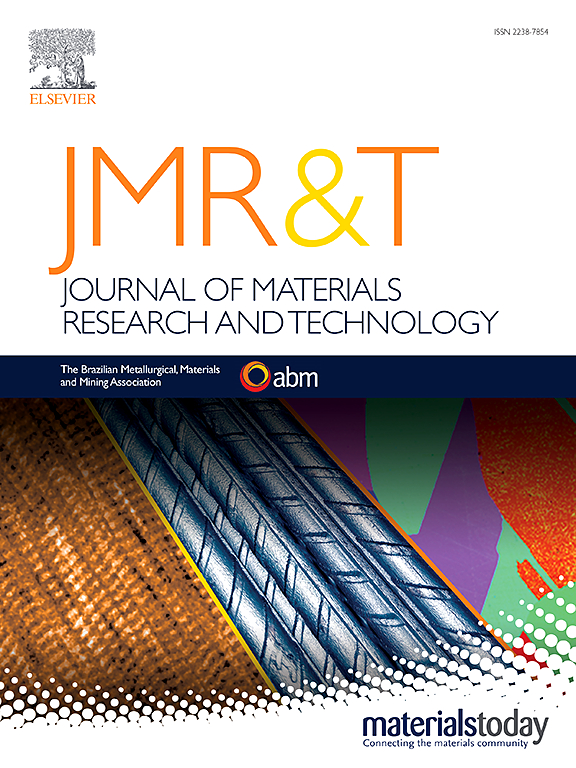球墨铸铁激光熔覆Inconel 625的多目标跨尺度优化方法
IF 6.6
2区 材料科学
Q1 MATERIALS SCIENCE, MULTIDISCIPLINARY
Journal of Materials Research and Technology-Jmr&t
Pub Date : 2025-06-04
DOI:10.1016/j.jmrt.2025.06.024
引用次数: 0
摘要
球墨铸铁是工业部件的关键部件,易受磨损和界面退化的影响。用Inconel 625进行激光熔覆可以通过冶金键合提供修复潜力,但现有的参数优化无法充分平衡机械、微观结构和界面协同作用。采用田口灰关联分析(GRA)对QT-600球墨铸铁In625涂层进行了多目标优化。具体而言,通过L16正交实验评估工艺参数(激光功率(P)、粉末进料速度(R)、扫描速度(V))与优化目标(显微硬度、孔隙率、弹性模量、稀释率、粘接强度)之间的映射关系。方差和信噪比分析显示,P对显微硬度、孔隙率和弹性模量具有统计学意义,而V主要影响稀释率和粘接强度。GRA将多个响应目标整合到单一灰色关联等级(GRG)中,产生最佳参数(P = 2400 W, R = 0.9 R /min, V = 8 mm/s)。验证实验表明,微硬度提高52.5%,孔隙率降低96.1%,稀释率提高11.2倍,结合强度提高59.4%,弹性模量略有降低。实验GRG(0.683)与预测值(0.680)非常吻合,证实了模型的可靠性。优化后的参数通过降低孔隙率、细化晶粒组织、促进Fe-Ni固溶体和连续的莱氏体,以及在部分熔化区生成双壳状莱氏体-马氏体组织,提高了硬度、弹性和结合强度。本文章由计算机程序翻译,如有差异,请以英文原文为准。
A multi-objective cross-scale optimization approach for high-performance Inconel 625 laser cladding on ductile iron
Ductile iron, critical for industrial components, suffers from wear and interfacial degradation. Laser cladding with Inconel 625 offers repair potential via metallurgical bonding, yet existing parameter optimizations inadequately balance mechanical, microstructural, and interfacial synergies. This study presents a multi-objective optimization of In625 coatings on QT-600 ductile iron using Taguchi-grey relational analysis (GRA). Specifically, the mapping relationship between process parameters (laser power (P), powder feed rate (R), and scanning speed (V)) and optimization objectives (microhardness, porosity, elastic modulus, dilution rate, and bonding strength) is evaluated through L16 orthogonal experiments. Variance and signal-to-noise ratio analyses revealed P as statistically significant for microhardness, porosity, and elastic modulus, while V predominantly influenced dilution rate and bonding strength. GRA consolidated multi-response objectives into a single grey relational grade (GRG), yielding optimal parameters (P = 2400 W, R = 0.9 r/min, V = 8 mm/s). Validation experiments showed a 52.5 % increase in microhardness, 96.1 % lower porosity, 11.2-fold higher dilution rate, and 59.4 % improved bonding strength, with a slight elastic modulus reduction. Experimental GRG (0.683) closely matched predictions (0.680), confirming model reliability. Optimized parameters enhanced hardness, elasticity, and bonding strength by reducing porosity, refining grain structure, promoting Fe–Ni solid solutions and continuous ledeburite, and generating the dual-shell ledeburite-martensite structures in the the partially melted zone.
求助全文
通过发布文献求助,成功后即可免费获取论文全文。
去求助
来源期刊

Journal of Materials Research and Technology-Jmr&t
Materials Science-Metals and Alloys
CiteScore
8.80
自引率
9.40%
发文量
1877
审稿时长
35 days
期刊介绍:
The Journal of Materials Research and Technology is a publication of ABM - Brazilian Metallurgical, Materials and Mining Association - and publishes four issues per year also with a free version online (www.jmrt.com.br). The journal provides an international medium for the publication of theoretical and experimental studies related to Metallurgy, Materials and Minerals research and technology. Appropriate submissions to the Journal of Materials Research and Technology should include scientific and/or engineering factors which affect processes and products in the Metallurgy, Materials and Mining areas.
 求助内容:
求助内容: 应助结果提醒方式:
应助结果提醒方式:


